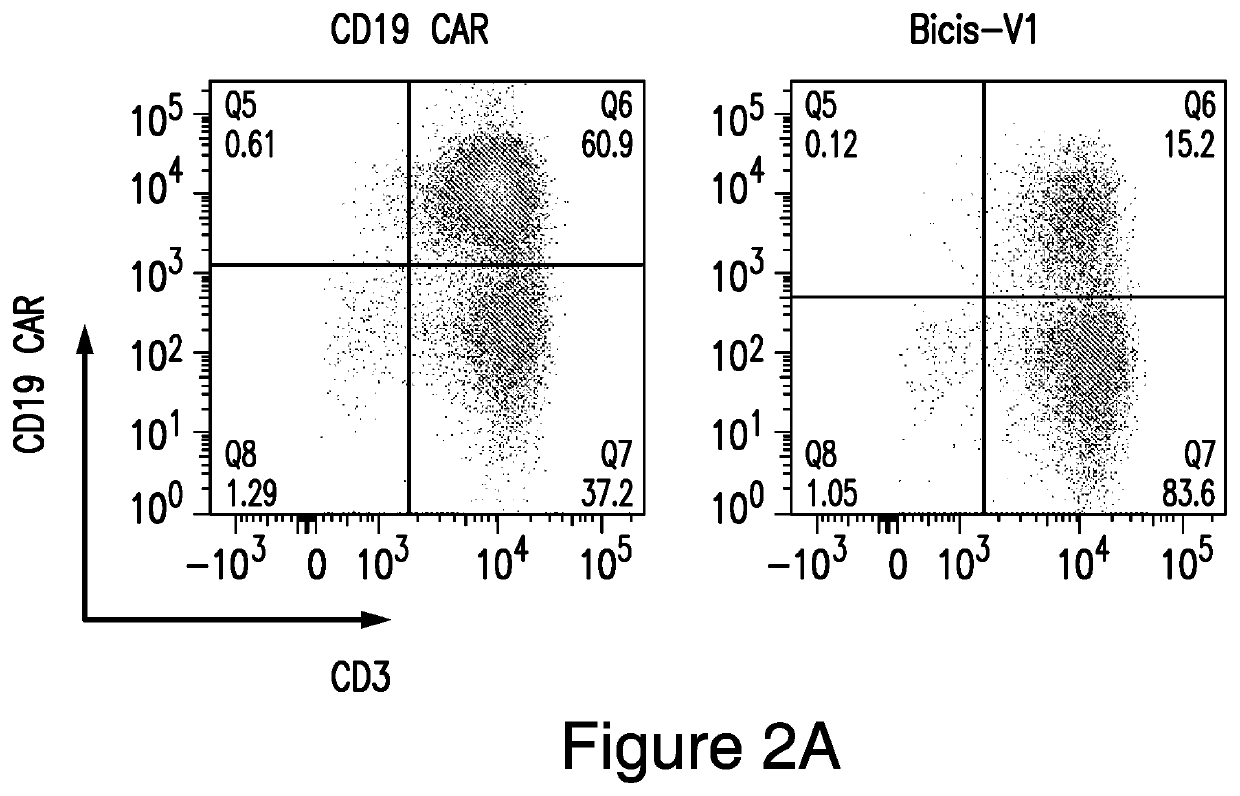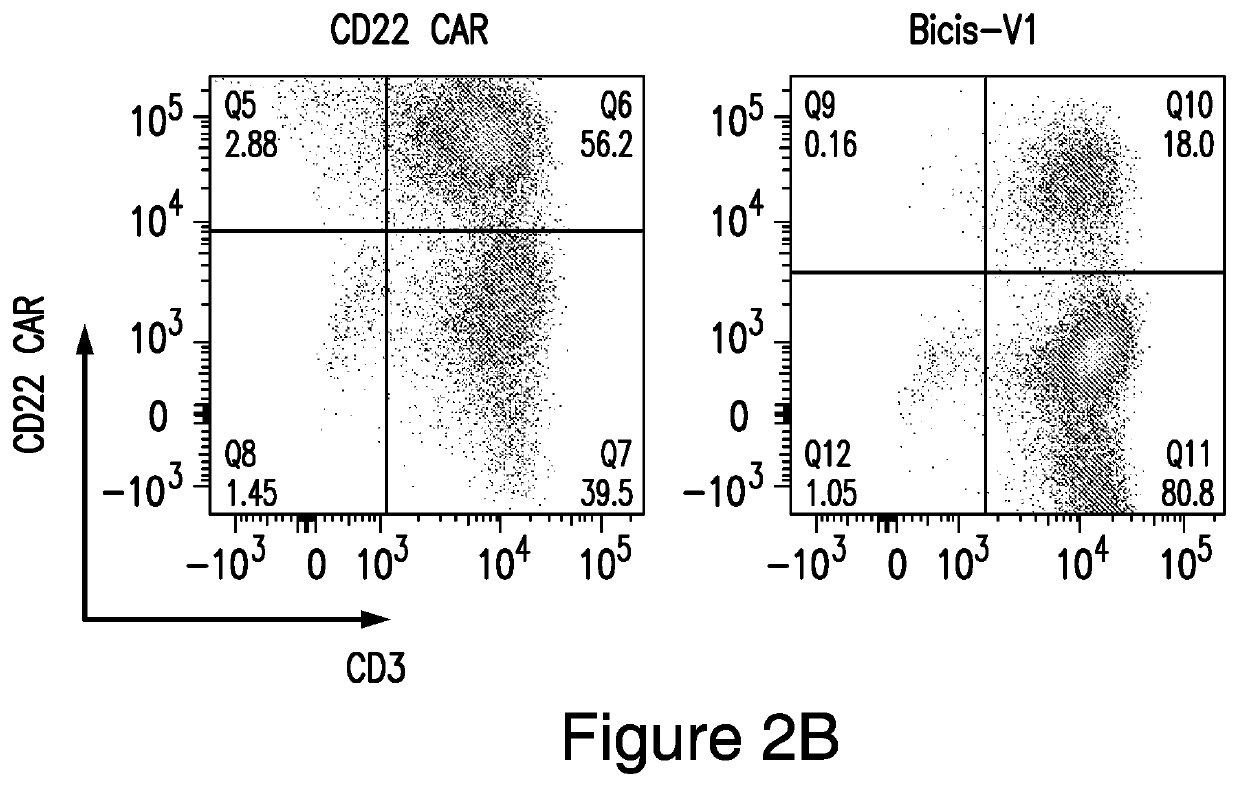Bicistronic chimeric antigen receptors and their uses
- Summary
- Abstract
- Description
- Claims
- Application Information
AI Technical Summary
Benefits of technology
Problems solved by technology
Method used
Image
Examples
example 1
[0239]This example demonstrates generation of CAR constructs, CAR construct-encoding lentiviral vectors, and CAR-expressing T cells, in accordance with embodiments of the invention, as well as generation of other CARs for comparison.
[0240]The CAR constructs were synthesized by GENEWIZ (South Plainfield, N.J., USA) and then sub-cloned into the lenti-viral plasmid backbone between NhEl and HincII sites.
[0241]CAR construct-encoding lentiviral vectors were produced by transient transfection of the 293T cell line. Briefly, 293T cells were plated into poly-D lysine coated 15 cm plates (BD Biosciences, San Jose, Calif., USA). The following day, 293T cells were transfected using lipofectamine 3000 (Life Technologies, Calrsbad, Calif., USA) with plasmids encoding the CAR construct along with packaging and envelope vectors (pMDLg / pRRE, pMD-2G, and pRSV-Rev). Lentiviral supernatants were collected 48-72 hours post-transfection, centrifuged at 3000 RPM for 10 minutes to remove cell debris, then...
example 2
[0246]This example demonstrates surface expression on human T cells of CARs, cleaved from a CAR construct, in accordance with embodiments of the invention, compared to other CARs.
[0247]Surface expression of anti-CD19 CAR and anti-CD22 CAR on the V1 transduced T cells is about 15%, while the expression of the anti-CD19 CAR from a vector encoding only the single anti-CD19 CAR is 61% and expression of the anti-CD22 CAR from a vector encoding only the single anti-CD22 CAR is 56% (FIGS. 2A-2C).
[0248]Human PBMCs from a healthy donor were activated with CD3 / CD28 microbeads for 24 hours. Activated T cells were then transduced with vector individually or co-transduced with both the single anti-CD19 CAR and the single anti-CD22 CAR vectors together. Surface expression of the anti-CD19 CAR and the anti-CD22 CAR were analyzed on day 8. Cotransduced T cells had much lower expression of both anti-CD19 and anti-CD22 CARs compared to the bispecific LoopCAR6. The expression of anti-CD19 and anti-CD2...
example 3
[0250]This example demonstrates in vitro activity of a CAR construct based on cytokine production, in accordance with embodiments of the invention, compared to other CARs.
[0251]CAR-transduced T cells (1E5) were washed 3 times with 1×PBS and then co-incubated with an equal number of target cells in 200 ml RPMI media in 96-well plates in a 37° C. incubator for 15 to 20 hours. The target cells were K562 expressing CD19 or CD22 or both CD19 and CD22. K562 cells served as the negative control. The cytokine levels of the IL2 and IFNα in the culture supernatant were measured with an ELISA kit (R&D Systems, Minneapolis, Minn., USA). All tests were set in triplicates. V1 CAR T cells made plenty of IL2 and IFNg when co-cultured with CD22 expression target cells, but made only low level of IL2 and IFNg when co-cultured with CD19 expression target cells (FIGS. 5A and 5B).
[0252]CML cell line K562 was artificially transduced with CD19 or CD22 or both to express the target antigens. K562 cells ser...
PUM
| Property | Measurement | Unit |
|---|---|---|
| Fraction | aaaaa | aaaaa |
| Current | aaaaa | aaaaa |
| Volume | aaaaa | aaaaa |
Abstract
Description
Claims
Application Information
 Login to View More
Login to View More - R&D
- Intellectual Property
- Life Sciences
- Materials
- Tech Scout
- Unparalleled Data Quality
- Higher Quality Content
- 60% Fewer Hallucinations
Browse by: Latest US Patents, China's latest patents, Technical Efficacy Thesaurus, Application Domain, Technology Topic, Popular Technical Reports.
© 2025 PatSnap. All rights reserved.Legal|Privacy policy|Modern Slavery Act Transparency Statement|Sitemap|About US| Contact US: help@patsnap.com



